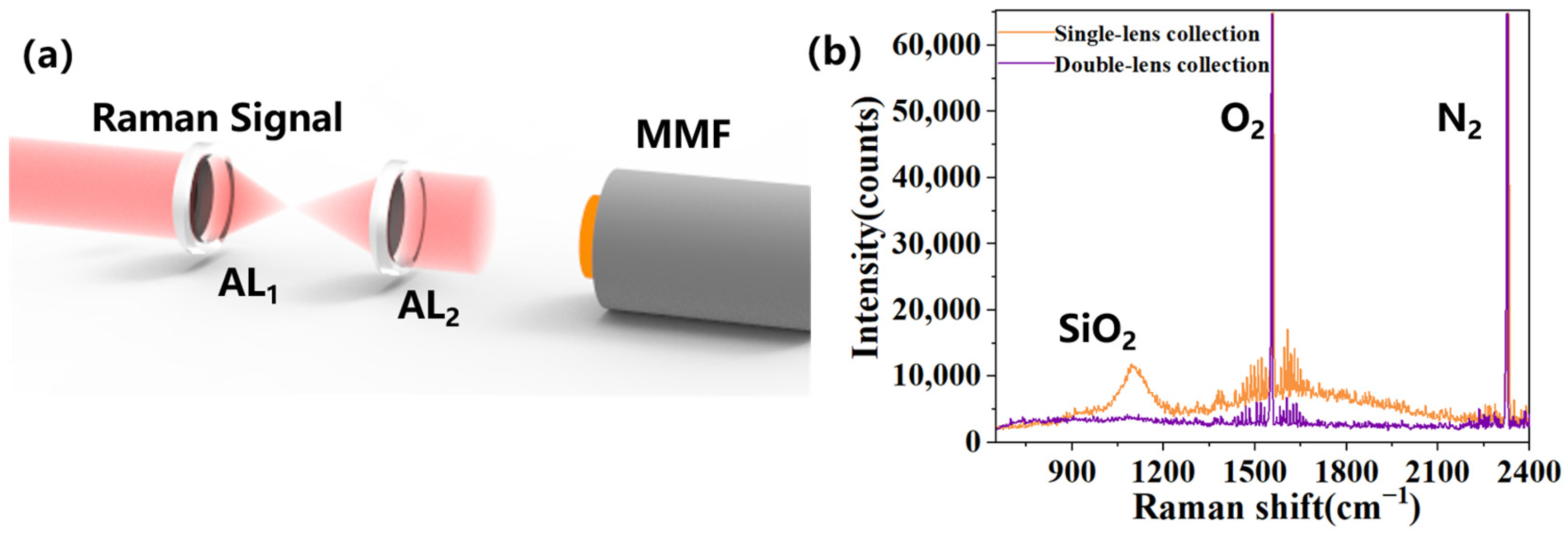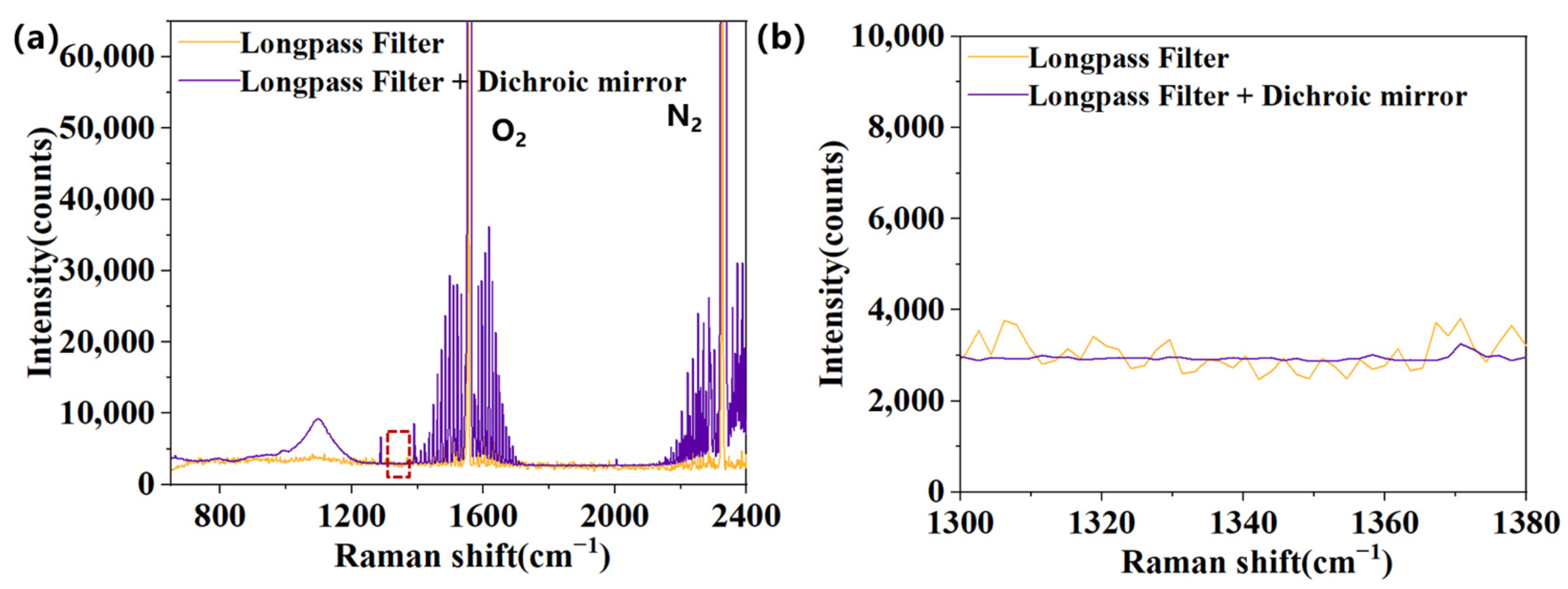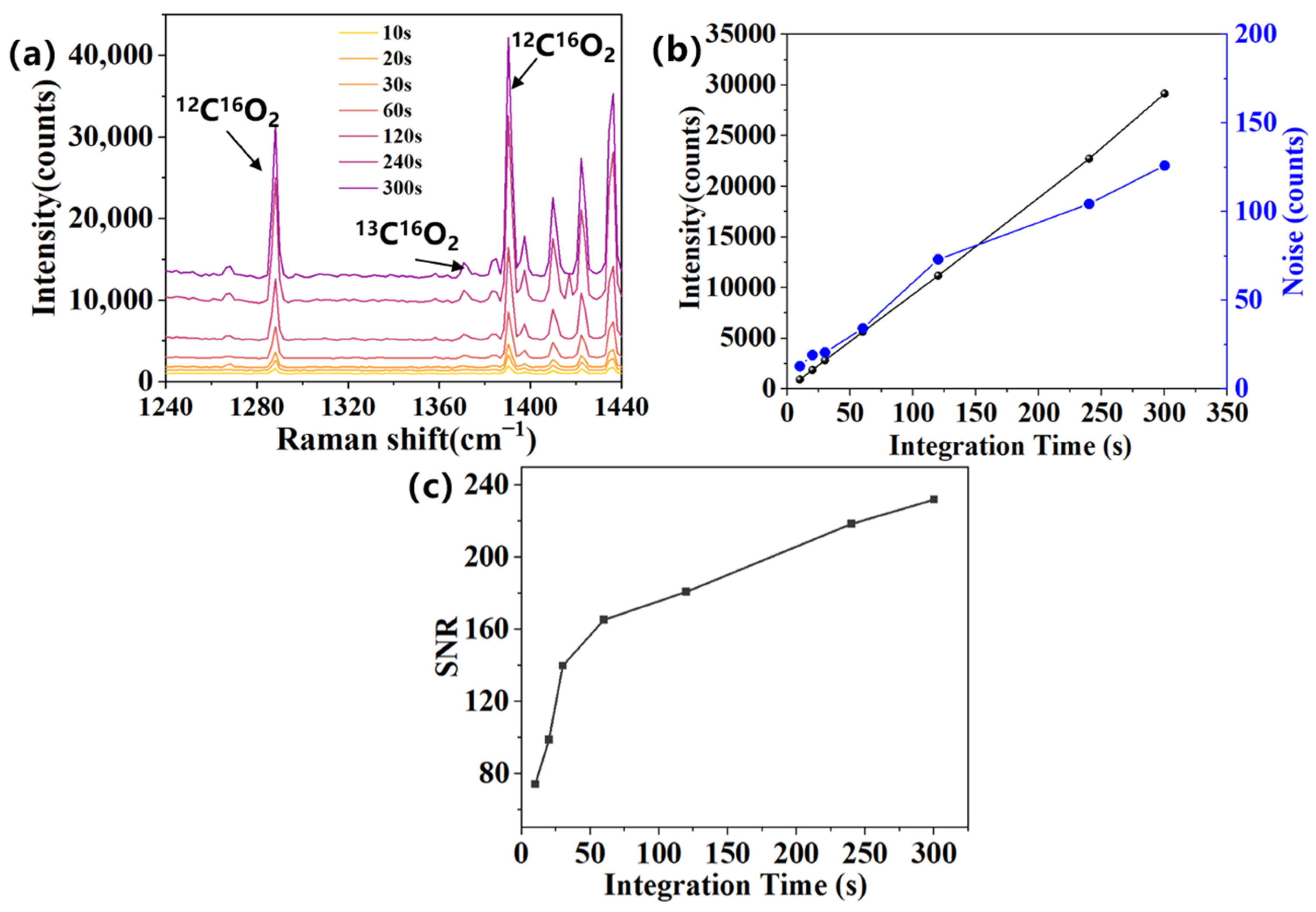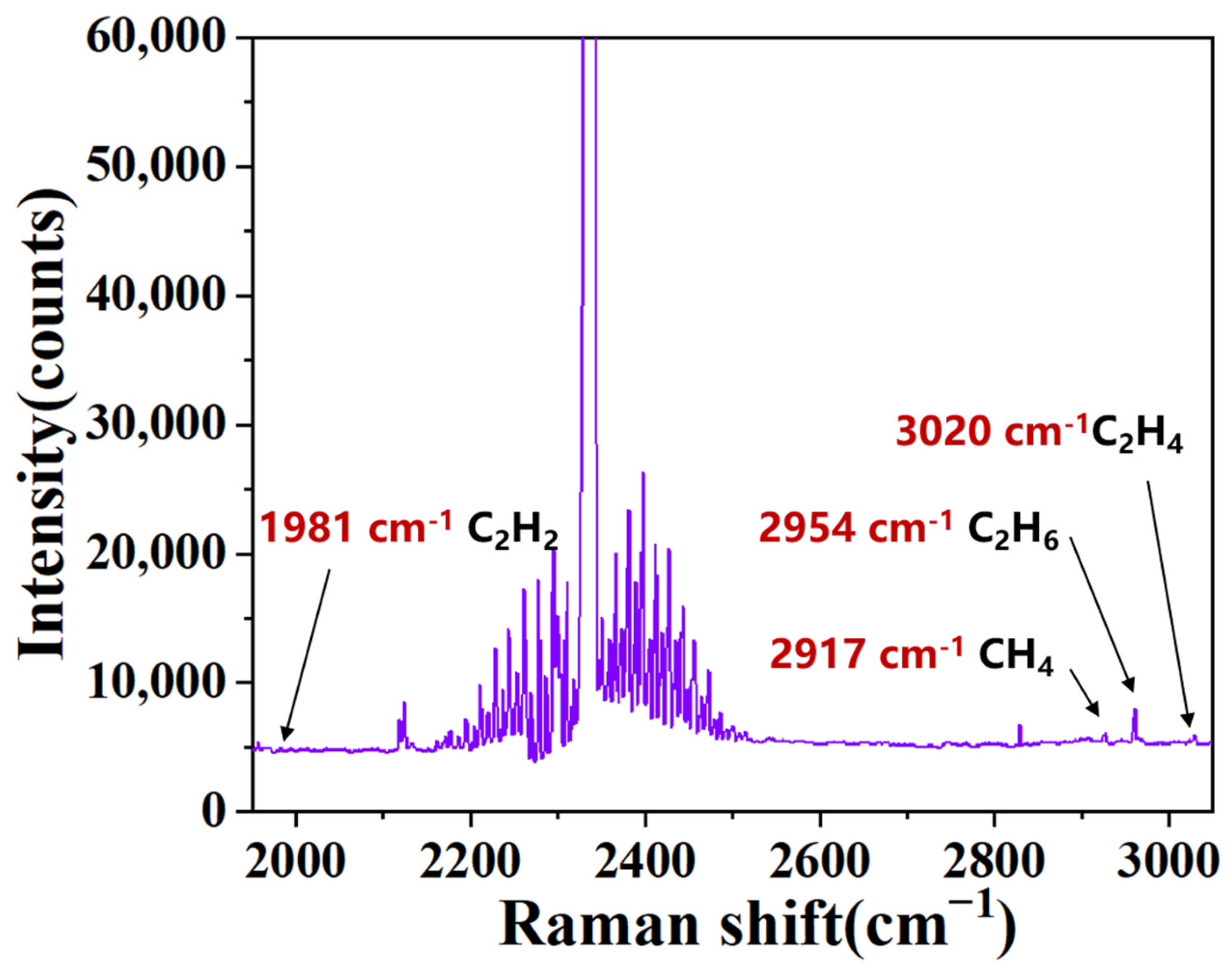Trace Gas Monitoring by Hollow-Core Anti-Resonant Fiber-Enhanced Raman Spectroscopy with Sub-ppm Sensitivity
Abstract
1. Introduction
2. Experimental Setup
3. Experimental Details
3.1. Apparatus for Background Noise Suppression
3.2. Spatial Filtering Method
4. Experimental Results
5. Conclusions
Author Contributions
Funding
Data Availability Statement
Conflicts of Interest
References
- Li, C.; Dong, L.; Zheng, C.; Tittel, F.K. Compact TDLAS based optical sensor for ppb-level ethane detection by use of a 3.34 μm room-temperature CW interband cascade laser. Sens. Actuators B Chem. 2016, 232, 188–194. [Google Scholar] [CrossRef]
- He, Y.; Ma, Y.; Tong, Y.; Yu, X.; Tittel, F.K. Ultra-high sensitive light-induced thermoelastic spectroscopy sensor with a high Q-factor quartz tuning fork and a multipass cell. Opt. Lett. 2019, 44, 1904–1907. [Google Scholar] [CrossRef]
- Cui, R.; Dong, L.; Wu, H.; Ma, W.; Xiao, L.; Jia, S.; Chen, W.; Tittel, F.K. Three-dimensional printed miniature fiber-coupled multipass cells with dense spot patterns for ppb-level methane detection using a near-IR diode laser. Anal. Chem. 2020, 92, 13034–13041. [Google Scholar] [CrossRef]
- Dong, L.; Tittel, F.K.; Li, C.; Sanchez, N.P.; Wu, H.; Zheng, C.; Yu, Y.; Sampaolo, A.; Griffin, R.J. Compact TDLAS based sensor design using interband cascade lasers for mid-IR trace gas sensing. Opt. Express 2016, 24, A528–A535. [Google Scholar] [CrossRef]
- Ma, Y.; He, Y.; Tong, Y.; Yu, X.; Tittel, F.K. Quartz-tuning-fork enhanced photothermal spectroscopy for ultra-high sensitive trace gas detection. Opt. Express 2018, 26, 32103–32110. [Google Scholar] [CrossRef]
- Mondello, L.; Tranchida, P.Q.; Dugo, P.; Dugo, G. Comprehensive two-dimensional gas chromatography-mass spectrometry: A review. Mass Spectrom. Rev. 2008, 27, 101–124. [Google Scholar] [CrossRef]
- Nedjalkov, A.; Meyer, J.; Köhring, M.; Doering, A.; Angelmahr, M.; Dahle, S.; Sander, A.; Fischer, A.; Schade, W. Toxic gas emissions from damaged lithium ion batteries—Analysis and safety enhancement solution. Batteries 2016, 2, 5. [Google Scholar] [CrossRef]
- Schmidt, F.M.; Foltynowicz, A.; Ma, W.; Axner, O. Fiber-laser-based noise-immune cavity-enhanced optical heterodyne molecular spectrometry for Doppler-broadened detection of C2H2 in the parts per trillion range. J. Opt. Soc. Am. B 2007, 24, 1392–1405. [Google Scholar] [CrossRef]
- Weber, A. Raman Spectroscopy of Gases and Liquids; Springer Science & Business Media: Berlin/Heidelberg, Germany, 2012; Volume 11. [Google Scholar]
- Zhou, Y.; Liu, J.; Guo, S.; Zhao, G.; Ma, W.; Cao, Z.; Dong, L.; Zhang, L.; Yin, W.; Wu, Y. Laser frequency stabilization based on a universal sub-Doppler NICE-OHMS instrumentation for the potential application in atmospheric lidar. Atmos. Meas. Technol. 2019, 12, 1807–1814. [Google Scholar] [CrossRef]
- Kong, W.; Wan, F.; Wang, R.; Sun, H.; Chen, W. Signal enhancement and noise suppression technologies in Raman spectroscopic gas sensing. Appl. Phys. Rev. 2025, 12, 011334. [Google Scholar] [CrossRef]
- Pearman, W.F.; Carter, J.C.; Angel, S.M.; Chan, J.W. Multipass capillary cell for enhanced Raman measurements of gases. Appl. Spectrosc. 2008, 62, 285–289. [Google Scholar] [CrossRef] [PubMed]
- Zhao, J.; Cao, X.; Xu, W.; Xu, S. Waveguide—based Raman enhancement strategies. J. Raman Spectrosc. 2023, 55, 355–376. [Google Scholar] [CrossRef]
- Nie, Q.; Liu, Z.; Cheng, M.; Pei, S.; Yang, D.; Guo, D.; Yang, M. Review on Hollow-Core Fiber Based Multi-Gas Sensing Using Raman Spectroscopy. Photonic Sens. 2024, 14, 240412. [Google Scholar] [CrossRef]
- Wang, J.; Chen, W.; Wang, P.; Wan, F.; Zhang, Z.; Gao, S.; Wang, Y. Analysis of SF6 decomposed products by fibre-enhanced Raman spectroscopy for gas-insulated switchgear diagnosis. High Volt. 2023, 9, 206–216. [Google Scholar] [CrossRef]
- Blohm, A.; Domes, C.; Frosch, T. Isotopomeric Peak Assignment for N2O in Cross-Labeling Experiments by Fiber-Enhanced Raman Multigas Spectroscopy. Anal. Chem. 2024, 96, 2883–2892. [Google Scholar] [CrossRef]
- Pearman, W.F.; Carter, J.C.; Angel, S.M.; Chan, J.W. Quantitative measurements of CO2 and CH4 using a multipass Raman capillary cell. Appl. Opt. 2008, 47, 4627–4632. [Google Scholar] [CrossRef]
- Khannanov, M.N.; Kirpichev, V.E. Express analysis of natural gas and gas mixtures using a portable Raman spectrometer coupled to a hollow photon-crystal light guide. Bull. Russ. Acad. Sci. Phys. 2021, 85, 169–173. [Google Scholar] [CrossRef]
- Khannanov, M.N.; Vankov, A.B.; Novikov, A.A.; Semenov, A.P.; Gushchin, P.A.; Gubarev, S.I.; Kirpichev, V.E.; Morozova, E.N.; Kulik, L.V.; Kukushkin, I.V. Analysis of natural gas using a portable hollow-core photonic crystal coupled Raman spectrometer. Appl. Spectrosc. 2020, 74, 1496–1504. [Google Scholar] [CrossRef]
- Knebl, A.; Domes, R.; Yan, D.; Popp, J.; Trumbore, S.; Frosch, T. Fiber-Enhanced Raman Gas Spectroscopy for 18O-13C-Labeling Experiments. Anal. Chem. 2019, 91, 7562–7569. [Google Scholar] [CrossRef]
- Knebl, A.; Domes, R.; Wolf, S.; Domes, C.; Popp, J.; Frosch, T. Fiber-Enhanced Raman Gas Spectroscopy for the Study of Microbial Methanogenesis. Anal. Chem. 2020, 92, 12564–12571. [Google Scholar] [CrossRef]
- Knebl, A.; Domes, C.; Domes, R.; Wolf, S.; Popp, J.; Frosch, T. Hydrogen and C2-C6 Alkane Sensing in Complex Fuel Gas Mixtures with Fiber-Enhanced Raman Spectroscopy. Anal. Chem. 2021, 93, 10546–10552. [Google Scholar] [CrossRef]
- Yan, D.; Popp, J.; Frosch, T. Analysis of fiber-enhanced Raman gas sensing based on Raman chemical imaging. Anal. Chem. 2017, 89, 12269–12275. [Google Scholar] [CrossRef]
- Voigtman, E. Limits of detection and decision. Part 1. Spectrochim. Acta Part B At. Spectrosc. 2008, 63, 115–128. [Google Scholar] [CrossRef]








| Gas | Gas Concentration/ppm | Raman Shift/cm−1 | Signal-To-Noise Ratio | LOD/ppm |
|---|---|---|---|---|
| CH4 | 5.1 | 2917 | 6.1 | 2.5 |
| C2H2 | 5.2 | 1981 | 5.7 | 2.7 |
| C2H4 | 5.4 | 3020 | 5.7 | 2.84 |
| C2H6 | 5.2 | 2954 | 27.2 | 0.57 |
Disclaimer/Publisher’s Note: The statements, opinions and data contained in all publications are solely those of the individual author(s) and contributor(s) and not of MDPI and/or the editor(s). MDPI and/or the editor(s) disclaim responsibility for any injury to people or property resulting from any ideas, methods, instructions or products referred to in the content. |
© 2025 by the authors. Licensee MDPI, Basel, Switzerland. This article is an open access article distributed under the terms and conditions of the Creative Commons Attribution (CC BY) license (https://creativecommons.org/licenses/by/4.0/).
Share and Cite
Zhu, X.; Yu, H.; Wang, X.; Meng, Y.; Liu, H.; Lian, H.; Lian, Q. Trace Gas Monitoring by Hollow-Core Anti-Resonant Fiber-Enhanced Raman Spectroscopy with Sub-ppm Sensitivity. Photonics 2025, 12, 1133. https://doi.org/10.3390/photonics12111133
Zhu X, Yu H, Wang X, Meng Y, Liu H, Lian H, Lian Q. Trace Gas Monitoring by Hollow-Core Anti-Resonant Fiber-Enhanced Raman Spectroscopy with Sub-ppm Sensitivity. Photonics. 2025; 12(11):1133. https://doi.org/10.3390/photonics12111133
Chicago/Turabian StyleZhu, Xuran, Hanwen Yu, Xiao Wang, Yanzong Meng, Huixin Liu, Hongsong Lian, and Qingwen Lian. 2025. "Trace Gas Monitoring by Hollow-Core Anti-Resonant Fiber-Enhanced Raman Spectroscopy with Sub-ppm Sensitivity" Photonics 12, no. 11: 1133. https://doi.org/10.3390/photonics12111133
APA StyleZhu, X., Yu, H., Wang, X., Meng, Y., Liu, H., Lian, H., & Lian, Q. (2025). Trace Gas Monitoring by Hollow-Core Anti-Resonant Fiber-Enhanced Raman Spectroscopy with Sub-ppm Sensitivity. Photonics, 12(11), 1133. https://doi.org/10.3390/photonics12111133





